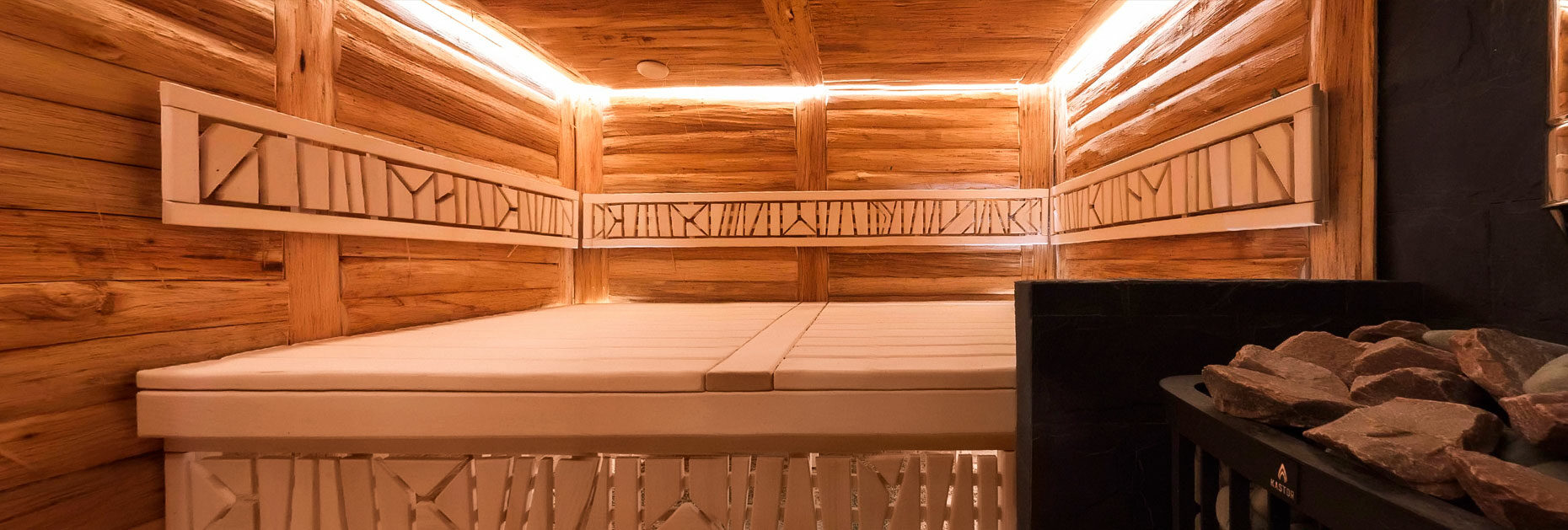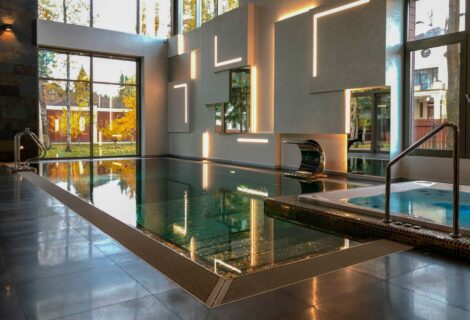Construction of saunas is not only the process of creating a secluded place for relaxation, but also an opportunity to bring to life a unique corner of comfort in your home. From selecting materials to creating a cozy atmosphere, every stage of sauna construction is filled with opportunities to transform this space into a source of well-being and relaxation.
Selection of wood for finishing
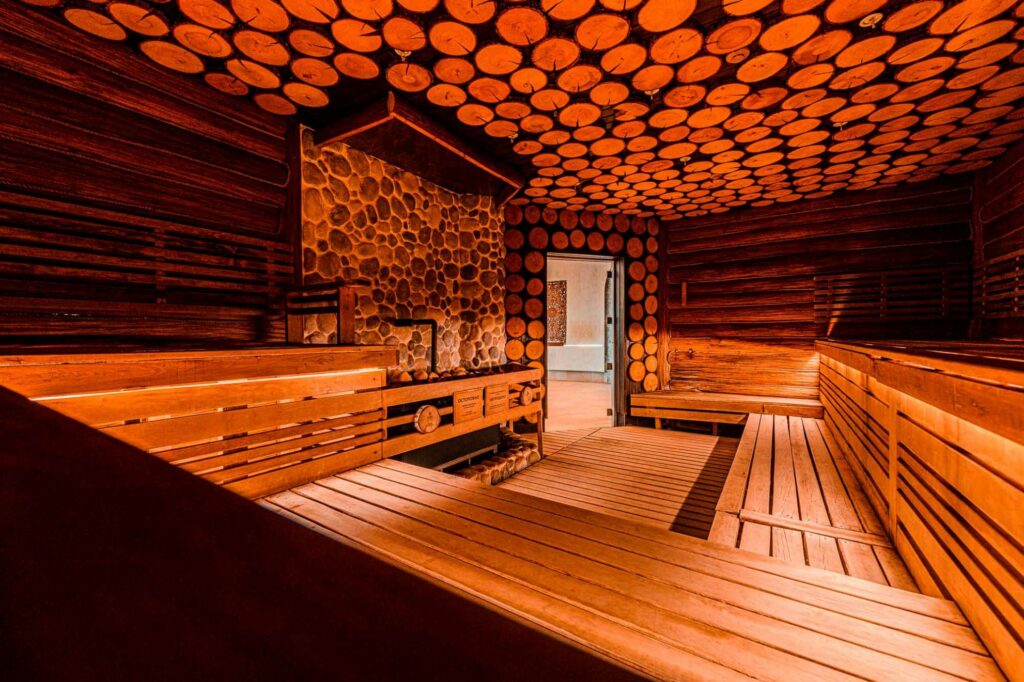 When designing saunas, the choice of wood for interior decoration plays an important role. The correct choice of material affects the quality and aesthetics of the sauna, as well as the feeling of comfort during relaxation.
When designing saunas, the choice of wood for interior decoration plays an important role. The correct choice of material affects the quality and aesthetics of the sauna, as well as the feeling of comfort during relaxation.
- When choosing wood for a sauna, it is important to take into account its properties in relation to vapor permeability and lightness. Soft woods, such as spruce or ash, tolerate high humidity and withstand temperature changes, ensuring long-term use.
- No Resins or Odors: Some woods, such as aspen or fir, have low amounts of resins and odors, making them an excellent choice for saunas where clean air and the absence of heavy odors are important.
- Durability and stability: The service life of wood in a sauna depends on its strength and resistance to moisture and heat. Species such as cedar or thermal wood are highly resistant to moisture and temperature changes, ensuring long-term operation.
- Aesthetics and Visual Perception: Each breed has its own unique textures and colors that affect the visual appearance of the sauna. Larch or pine can create a warm and cozy atmosphere, while cedar or thermal wood adds elegance and sophistication.
Advantages and disadvantages of different types of wood
Different types of wood have their own unique characteristics that make them attractive or less suitable for use in a sauna. Features of different breeds:
Spruce tolerates high humidity well and is resistant to thermal changes, but it is also a soft species that is prone to scratches and deformation if used improperly.
Pine – pleasant aroma and natural aesthetics. This is durability with proper care.
But tarry discharge may appear. Due to its low density, it may be more susceptible to moisture.
Cedar is highly resistant to rot and fungi due to the content of natural oils. Has a pleasant aroma. But it is expensive and may require special care.
Larch is resistant to moisture and decay, has an aesthetic appearance and texture. Color may change over time. High price compared to other breeds.
The choice of wood for finishing a sauna depends on preferences in appearance, resistance to moisture, cost and individual characteristics of each type. All these aspects should be taken into account when choosing a suitable material.
Choice of colors and decor for the sauna
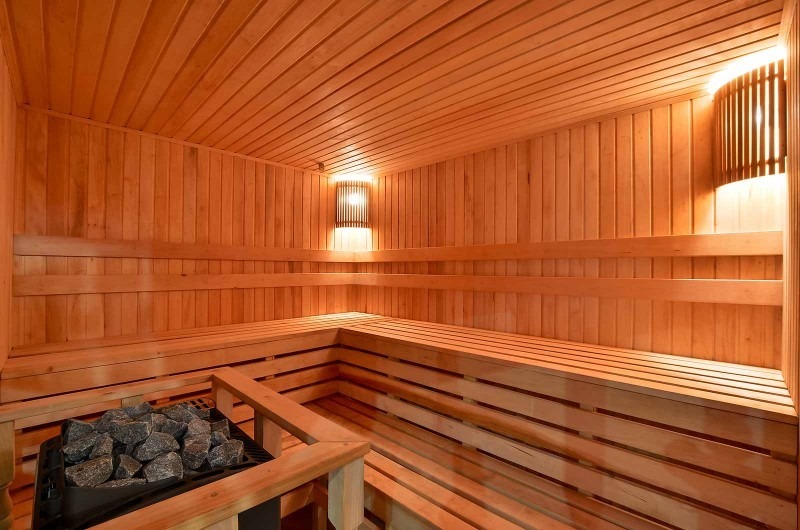 The choice of colors and decor for the sauna depends on your preferences, interior style and the desired overall atmosphere in the room. It is important to create a comfortable space that combines aesthetics, functionality and a relaxing atmosphere to fully enjoy your sauna session.
The choice of colors and decor for the sauna depends on your preferences, interior style and the desired overall atmosphere in the room. It is important to create a comfortable space that combines aesthetics, functionality and a relaxing atmosphere to fully enjoy your sauna session.
The use of natural colors – from light brown to golden and light green shades – gives the sauna a feeling of calm and harmony with nature.
Additional elements in brighter or contrasting colors can create an interesting visual effect.
Using light colors expands the space and makes the sauna feel more airy.
If you prefer a classic style, traditional shades such as red, brown or orange can add warmth and coziness to your sauna.
Modern interiors are characterized by neutral colors, black and white, or graphic lines that emphasize the lines and shapes of the room.
In addition to color, the use of natural stones, lighting, glass or metal elements in sauna decor can create a unique and impressive look.
Integration of a sauna into the overall interior of the house
Integrating a sauna into the overall interior of the house allows you to create a harmonious and functional space for rest and relaxation. Several ways to successfully introduce a sauna into your home interior:
- Create a dedicated spa area, including a sauna, jacuzzi and comfortable seating areas.
- Choose a sauna finish that matches the overall style of your home.
- Provide a separate sauna space that is private and functional.
- Try to add more natural light to your sauna design if possible.
- Think about the lighting in your sauna. Soft and diffuse lighting can create an atmosphere of relaxation. You can also pay attention to various decorative elements.
- Provide space for relaxation after a sauna session, the possibility of taking a shower or refreshing yourself.
How to make a small sauna space cozy and functional
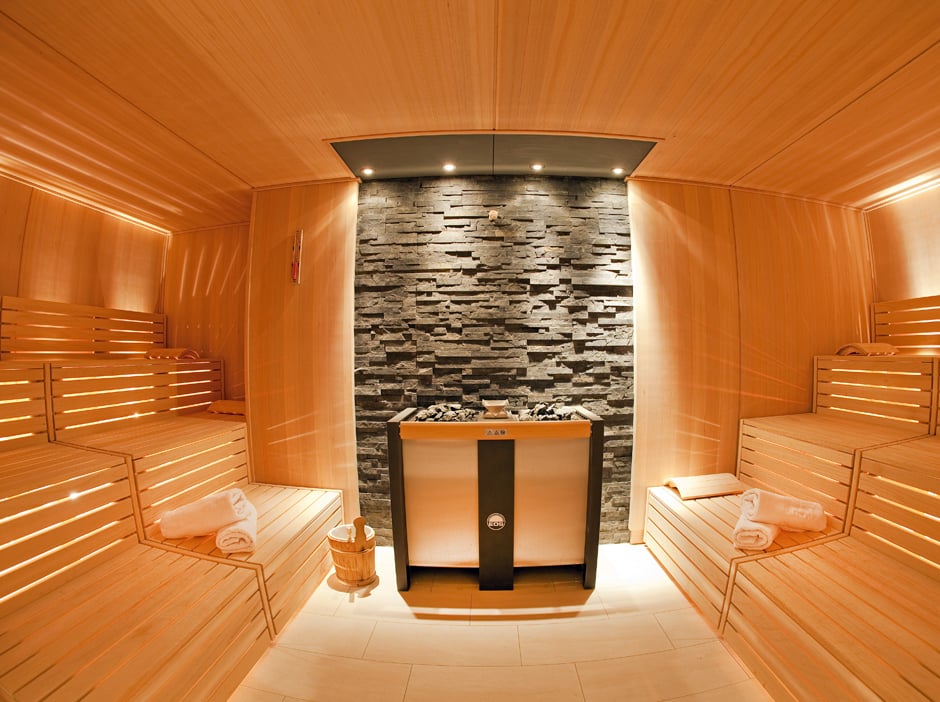 This can be done using several steps:
This can be done using several steps:
- Use compact and functional furniture that suits the size of the room. Benches, cabinets or shelves should be comfortable, but not take up too much space.
- Create a pleasant atmosphere with soft lighting. Soft light or lighting will help create comfort inside the sauna.
- Use natural materials that give coziness and warmth, such as wood.
- Use light and neutral colors for decoration; they will help visually expand the space and add light.
- Optimize the use of space so that it is functional. Place everything you need in a way that is convenient and practical.
- Provide good ventilation to maintain fresh air inside the sauna. This is important to create a comfortable atmosphere.
- Add decorative elements that will add coziness, such as fluffy towels, candles or small plants. But remember that humidity can affect some items, so choose accessories based on the sauna conditions.
A small sauna space can become cozy and functional if you pay attention to proper organization and use of every centimeter of the room to create a comfortable and pleasant environment.
Laying pipes and communications
Laying pipes and communications in a sauna is an important stage that requires attention to detail and knowledge of the features of working in a high-temperature environment. Here are a few key points:
- When laying pipes for water supply and steam, it is necessary to choose materials that are resistant to high temperatures and humidity. For example, copper pipes are often used for plumbing systems because they resist heat and do not corrode.
- Pipes must be insulated and protected from high temperatures. Using thermal insulation materials will help prevent overheating and maintain system efficiency.
- Pipes should be laid so that they do not interfere with the use of the sauna. They can pass under the floor, in the walls or through special outlets. It is important to ensure easy access to the system for maintenance and repair.
- It is better to entrust the work of laying pipes and communications to experienced specialists who know the specifics of working in a sauna. They will be able to correctly calculate and install all the necessary elements.
- When working with communications in a sauna, it is necessary to comply with all safety standards and regulations, taking into account the specifics of high temperatures and humidity.
Correct installation of pipes and communications in the sauna will ensure efficient operation of the system, safety of materials and, no less important, safety for sauna users.
Electrical equipment and power limitations
Electrical equipment in a sauna requires special attention due to high temperatures and humidity, which can affect its safety and performance.
- Selection of specialized materials
- Correct installation
- Power limitation:
- Work under the supervision of a professional
Proper installation and maintenance of electrical equipment will help avoid safety problems and keep your sauna operating efficiently. Compliance with all safety standards and regulations is important to prevent possible emergency situations.
Ventilation problems and their solutions
 Ventilation problems in a sauna can lead to several problems.
Ventilation problems in a sauna can lead to several problems.
- If ventilation is ineffective, condensation may form on the walls or ceiling of the sauna. The solution may be to install a more efficient ventilation system or use materials with increased moisture resistance.
- Insufficient air circulation can lead to overheating or uneven heat distribution in the sauna. To solve this problem, you can add additional vents or install a fan to improve air circulation.
- If ventilation fails to remove moisture, it can lead to an unpleasant feeling of stuffiness and even create conditions for the development of mold. To solve the problem, it is necessary to improve ventilation by adding additional ducts or installing a powerful ventilation system.
- Regular cleaning of ventilation ducts and filters will help prevent blockages, allowing ventilation to operate more efficiently.
- When building a sauna, it is important to use materials that can withstand high temperatures and humidity, which will help avoid many ventilation problems.
Solutions to sauna ventilation problems can vary depending on their nature and cause. A thorough investigation of the situation is often required to determine the best method of improving ventilation.
Planning a budget for building a sauna in the house
Planning a budget for building a sauna depends on many factors. Let’s look at some key aspects:
- Sauna size
- Materials
- Equipment
- Additional functions
- Work and services of professionals
To create a budget, determine the size of the sauna and select the types of materials and equipment. Conduct market research to estimate prices for materials and professional services. Please note that additional functions and features can significantly affect the final cost.
The best way to create a budget is to contact professionals in the field or consultants who can help estimate the necessary costs of building a sauna in your home.
Experience using your own sauna at home
The sauna has the following advantages:
- After a hard day, the sauna becomes an oasis of calm. In high temperatures, muscles relax, stress is relieved, and this promotes overall relaxation.
- It helps cleanse the body through sweating, improves blood circulation, helps eliminate toxins and strengthens the immune system.
- This is a great opportunity to enjoy solitude, meditate, read a book or just relax in silence.
- A sauna can be a great place to gather with family and friends, providing a cozy space to socialize and have a good time.
- Regular visits to the sauna can have a positive effect on the condition of the skin, the cardiovascular system, and also help relieve pain in muscles and joints.
Each sauna experience is unique and depends on preference, health, and personal goals. The main thing is to follow the recommendations for the time you spend in the sauna, drink enough water and, of course, enjoy this amazing experience.
